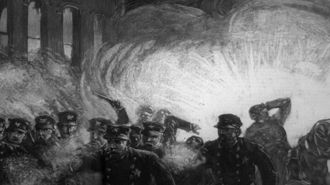
Haymarket: The Bomb, The Anarchists, The Labor Struggle 2021
Distributed by New Day Films, 350 North Water Street Unit 1-12, Newburgh, NY 12550; 888-367-9154
Produced by Adrian Prawica and Rafał Muskała
Directed by Adrian Prawica
Streaming, 56 mins
Middle School - General Adult
Documentaries; Industrial Relations; Labor Movement
Date Entered: 11/02/2023
Reviewed by Bryan Schuff, Assistant Librarian, SUNY GeneseoThe Haymarket Affair of May 4, 1886, in Chicago, Illinois, was explosive in literal and metaphorical terms; what began as a peaceable rally for an eight-hour workday during the "high water mark" of the labor movement came to a violent end when seven police officers and four civilians died by the blast of a dynamite bomb tossed into the crowd. In just under one hour, this documentary analyzes the conditions that lit the fuse leading up to the event, the lasting impact of the labor movement, and how interwoven it was with socialism and anarchism. Primary sources such as newspaper clippings, maps, political cartoons, flyers, and courtroom sketches provide excellent insight into the prevailing sentiments about industry and labor at the time in Chicago, in the United States, and even abroad. Photographs and film clips provide further support by depicting the factory and living conditions of the working class which sparked the workers to strike. The events are arranged in chronological order and described by storytellers with careers as professors and historians of history and labor, who shed light on the background of the people involved and the historical context surrounding the event, and they analyze the significance (and parallels) today; some segments are conducted on location at Haymarket Square where a memorial has been erected. The narrative is sympathetic to the Haymarket Eight and bias is discussed explicitly in the documentary as being weaponized against the defendants by the prosecution. For example, one of the newspaper clippings highlights that "In their closing speeches the prosecution declared: '...They are no more guilty than the thousands who follow them. Gentlemen of the jury; convict these men, make examples of them...'" to emphasize the notion that the defendants were convicted for their ideas and not for their actions.
This documentary could potentially go longer than one hour to delve into theories about possible bombing suspects because none were ever conclusively identified, accused, or arrested, as well as the aftermath for the families of the Haymarket Eight including Lucy Parsons, who was the spouse of Albert Parsons (one of the four executed) and an activist in her own right. However, this documentary is not about the crime of the bombing, but rather about the labor movement, the eight people who were arrested for leading the strikes, and the ensuing "trial of the century," and it ends with the fates of those defendants. Three of the storytellers (Christy Clark-Pujara, Ph.D.; Leon Fink, Ph.D.; and Bridget Marshall, Ph.D.) are shown only in the first part of the film, "The Modern Worker," to comment on the industrialization of Lowell, MA, as a backstory to the labor movement; their insight would have been welcome throughout the remainder of the documentary, as well. The soundtrack suits the emotional tone set by the subject matter and is described by the subtitles at various times as ominous, somber, and tense music. The reenacted scenes and sound effects are so sparse as to be nearly superfluous and some of the newspaper images are pixelated, but these notes are minimally critical compared to the archival content and scholarly analysis presented, and they do not detract from the educational value and the overall quality of the content.
This documentary is suitable for audiences in middle school and on through undergraduate and graduate studies, especially in subjects related to American history, labor, and business, plus journalism as it discusses how the tone of press coverage changed between the bombing and the public executions. The content and length of this documentary could also fit into public television programming.
Awards:Audience Favorite, Workers Unite Film Festival, 2021; Official Selection, Europe International Film Festival, Warsaw & Valencia, 2021; Official Selection, Reel Work May Day Labor Film Festival, 2021
Published and licensed under the Creative Commons Attribution 4.0 license. Anyone can use these reviews, so long as they comply with the terms of the license.